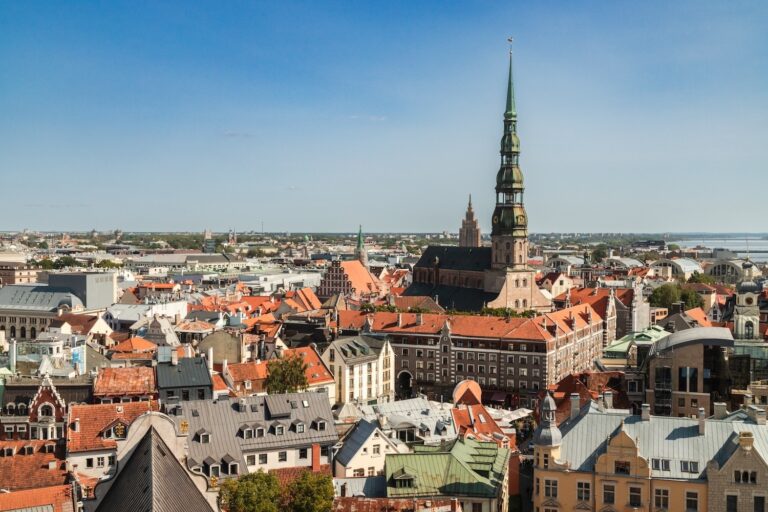Riga, Latvia – The spires and pinnacles of an old church rise above cobblestone streets lined with red brick buildings and pastel facades, reflecting centuries of conquest, trade and confessions.
Overshadowed by the well-known European capital, the capital of Latvia, the city, offers readers of this column a typical old world experience without crowds.

Riga was founded in 1201 by Bishop Albert von Buxhoeveden, a German who is more than just a high priest. He was also a crusade as this belt of Northern Europe (the lands of modern Estonia, Latvia and Lithuania) was the last pagan hub of Christian Europe. Much of the Christianization of the Baltic tribes, who called this land home, came with the sword of the Teutonic Knights.

Get the latest news for free
Subscribe to get daily/weekly emails with Top Stories (plus special offers!) from Christian Post. I know first.
This chapter of history comes to life in the old town (Vekriga, Latvia). There, the heritage of German Crusades, Hansietic League merchants, Swedish kings, Russian emperors and Soviet occupiers are engraved in the city. Anyone who has visited Gotland, Swedish island in Poland and the Hansiatic city of Visby in Gdansk will recognize the red brick cityscape.
The main landmark is Riga Cathedral (Rigadom, Latvia).
As the Cathedral is officially known, it dates back to the time of Bishop Albert, the Church of St. Mary’s Cathedral, but it is a masterpiece of medieval architecture. The original Romanesque traces, built and reconstructed over the centuries that followed, are blended seamlessly with Gothic arches and Baroque decorations. The place of worship endured through atheism imposed by a state of fire, war, reform and communist rule.

Once a Roman Catholic prince bishop wielded both the powers of both church and secular, the cathedral is today Lutheran and serves as the mother church of the evangelical Lutheran Church in Latvia. This is because unlike Orthodox Russia in the East and Roman Catholic Lithuania in the South, Latvia was ruled by German-speaking merchants and by aristocrats who accepted Martin Luther’s reformed theology in the early 1500s.
Among other great cultural treasures in Riga are hundreds of Art Nouveau buildings, located about a 10-minute walk from the old town.
In fact, experts say it is the home of Europe’s finest art nouveau architecture. A visit to the Riga Art Nouveau Museum, housed in a restored early 20th century apartment, offers a glimpse into the refined prewar lifestyle of the middle class of Riga before Soviet occupation changes everything.

The city’s overall elegance surprises many visitors and dispels the preconceived notions of an aging former Soviet city ruled by horrifying, brutal and Stalinist buildings. Although the artefacts of Soviet architecture remain, the elegance and cultural richness of the Latvian capital are accustomed to the European capital.
Riga is more than just a quaint old world city. That’s proof of resilience. Latvian culture, and, importantly, once-faithful followers, endured immense adversity and oppression under the Soviet regime. This remains a vivid living memory for many of the 600,000 souls who call the city home.
If you’re going
There are no non-stop flights from the US to Riga. Visitors must connect at least one. Air Baltotic, a national airline and partner of Delta Air Lines, is definitely the best European airline you’ve ever heard of. We offer services from all major European hubs.
The Marriott AC Hotel is a completely amazing hotel within walking distance of most attractions. For luxury, book a room at the 5-star Grand Hotel Kempinski. Another option is Hotel Gutenbergs, a family-run hotel with 38 rooms, located directly across from Riga Cathedral. They have a rooftop restaurant with fantastic views of the old town.

Riga Cathedral is open for visits Monday through Saturday from 10am to 5pm and Sunday from 10pm to 5pm. There is a reasonable admission fee. Highlights include the 12th century granite baptism font, which has been used for over 800 years to baptize faithful people and climbs the 217-stage cathedral tower.
The adjacent DOM Museum, located in a medieval corridor, categorizes artifacts and objects from the history of the cathedral. Most items show little information. Another recommended museum by the cathedral is the Museum of Riga and Navigation History.
Riga has two additional cathedrals. The Nativity of the Roman Catholic Cathedral of St. James and the Russian Orthodox Church of Christ. A medieval brick-built Gothic church, St. James has alternated between Lutheran and Roman Catholic rule since the Reform.
Everything can be walked, so it’s easy to go around. If you need a car, use Bolt, a riding application similar to Uber. Car rentals are required only for day trips. Recommended day trips include Cecisis Castle, a 13th century fortress, and Landhar Palace, the Baroque summer residence of the Duke of Courland, featuring its luxurious design and expansive gardens.
Dennis Lennox is a travel column for Christian Post.
Dennis Lennox writes about travel, politics and religion. He has appeared in the Financial Times, Independent, The Detroit News, Toronto Sun and other publications. Follow @dennislennox on Twitter.
